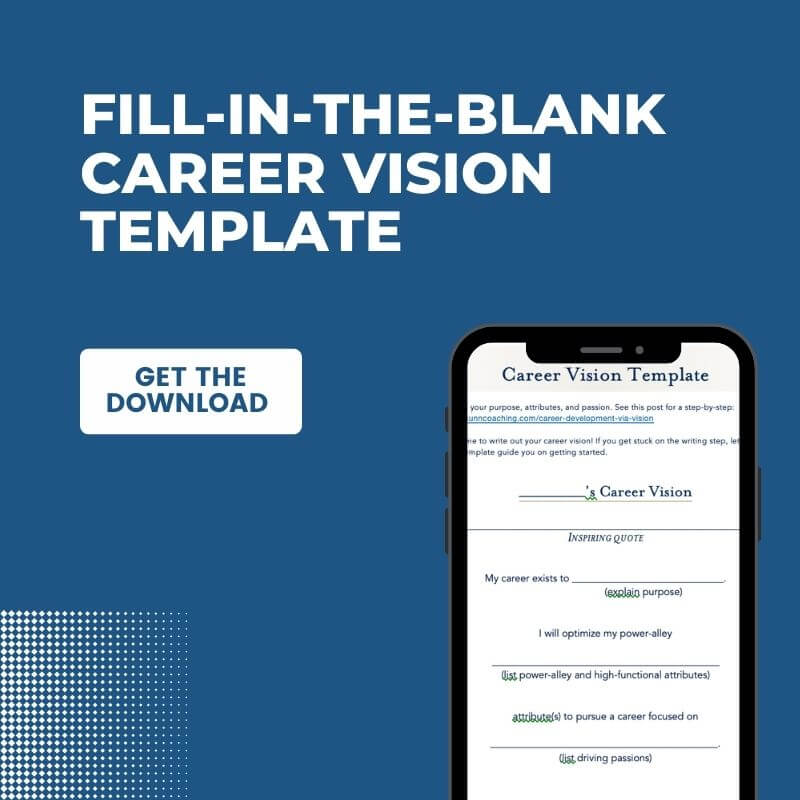Career development is about more than just “growing” your career. It’s about defining the career you want, and then mapping a path for getting there. In this post, we’ll explore a step-by-step approach to vision-driven career planning.
Just as a good gardener does some planning while dreaming of exciting growth ahead, so a smart professional will develop a long-term career growth plan before uprooting one role to cultivate something new.
This is where career vision comes into play.
Great news: creating this vision is fun and interesting—and you can start quickly. Here, we’ll discuss actionable career-development steps you can dig into right away:
- Why you want a career-development plan
- 4 steps for creating your career vision (plus a fill-in-the-blank template)
- What to do once you have a career vision
- 3 warnings before you get started
Why Should I Have a Career-Development Plan?
A career-development plan is your best tool for leading your career life—rather than letting your career lead you.
When it comes to work, many focus solely on what they perceive as “smart” careers—those that seem to offer good opportunity or earning potential. Others pursue careers that seem enjoyable (at least in the moment).
Neither of these approaches are pro-active, long-sighted plans for your professional future.
When you define your vision for your career path, you’re less likely to get suck in a rut or make reactive career choices, and more likely to move in the direction that supports you and your goals.

The secret to success is to focus on defining your career vision—the picture of where you want to end up. That’s the first step and the most lasting.
From there, you can make plans for moving toward your vision. But know that plans can and should change with action and context; vision only changes as your future picture shifts—which will happen, but usually in smaller ways. Because rather than your path guiding the destination, your destination will define the path.
Powerful, steady, and inspiring, your career vision is your guidepost for assessing your career path and making professional decisions and moves.
4 Steps to Defining Career Vision
Your dream career path will be found at the intersection of purpose, passion, and gift. Great fulfillment can lie in a career that captures all 3.
- Purpose: your “why”
- Gifts: your inherent attributes and natural talents
- Passion: what makes your eyes sparkle
Step 1: Discover Your Purpose
Unlike other components of your vision, purpose is not so much defined as it is discovered. That’s because purpose is more inherent, but over time, life often covers it under many complicated layers.
In addition, depending on your beliefs and background, purpose can have a strong spiritual component.
Because purpose is more complex and could take us off-topic, I will not explore it in great detail here, but rather direct you to other helpful resources on the topic:
- Blog posts:
- Book:
- Course:
You’re like a beautiful piece of furniture coated with many different layers of paint. Get ready to peel off the layers and find your true color!
Step 2: Understand Your Attributes
Are you a great speaker? Gifted with numbers? A fabulous encourager? Like physical attributes such as eye color or height, we all have natural personality attributes that set us apart.
These natural strengths are a magic ingredient in your future success and sense of fulfillment. So understand them, then learn to optimize them.
Once you’re doing so, you can also let your natural strengths guide you in mapping out a career-development vision that makes great use of the ways you’re built to be great. This approach is a key component to a more rewarding and meaningful career, because you will bring greater value when you’re working in line with your attributes.
As many of you know, I teach and write about this topic often. So check out these resources to get started on your strengths-discovery journey:
- Learn the 6 ways to identify high and low attributes (and much more) in the book Why Make Eagles Swim?
- Grab a strengths-instinct worksheet and learn about this fun first step in discovering your strengths here: “What are my strengths?”
- Take the attributes questionnaire
Step 3: Define your Passions
What lights you up? Create a list of things in life that make you feel energized, excited, and engaged. Here are some questions to get you started:
- Time flies when I am doing X.
- When I complete X activity, I feel more excited and energized than when I began.
- I can stay up until 2 am talking about X.
- People say I am very convincing when I talk about X.
Keep a list for a week or 2, then look for patterns.
This list does not need to connect to a professional career; it’s a brainstorm that will later help you unearth insights. Here’s a sample passions list:
- Team activities—both work and play
- Trying out new restaurants
- Learning about people in history
- Cooking new cuisines
- Playing on my club basketball team
- Checking out local farm markets
- Exploring new cultures
- Napping
There are no wrong answers!
When you have your list, go back through and look for patterns. Spend some time on this, until the picture starts to emerge.
For example, in the list above, it might be easy to see that we’re talking about a foodie. Great passion! Will it apply to the career vision? Maybe, maybe not.
But as we keep looking, a couple of other passion patterns emerge: this is someone who loves people and learning, and who probably prefers collaboration to solo work. These are driving passions that should likely be part of the career-development vision, because they will be essential to a fulfilling professional path.
(If you have trouble discovering such patterns from your own list, that’s very normal. Ask a trusted friend for insight, or connect with a coach for further guidance.)
Once you have your list of your higher level passion patterns, keep it close by when you write out your career vision (and when you review that vision in the future).
Step 4: Write (or Fill-in-the-Blank)
You have now outlined your purpose, and you have a list of attributes and high-level passions. Our final step is to write. Yes, write. You must write your career vision down!
If you hate writing, do bullets. It doesn’t need to be Shakespeare; it just needs to outline your purpose, your power-alley attributes, and your passions.
Use language that inspires you! Try to write it in a way that excites you as you type or move your pen. But if writing is hard for you, grab inspiring material from elsewhere—a favorite quote or line of poetry. I even had one client get started using song lyrics. Great idea!
Even so, since I know this writing step can be the most difficult, I’ve created a fill-in-the-blank document that you can use to draft your own career vision. Do not use this unless the writing step paralyzes you. But if it does, no shame in that! Grab the template here:
Career Vision: Done. Now what?
Once you have your career vision established, it’s time to find opportunities that complement your passions and attributes.
Inevitably, with your career vision in hand, you will be able to identify multiple career paths. And if you’re stumped, show your vision to a few people and ask them what careers sound compatible. You’ll get lots of ideas.
(A caveat: note the warning under “A Voice Will Try to Limit You” below—specifically the point about other people’s opinions. To protect yourself against this, be sure to avoid showing your vision to others until it’s complete and you are completely confident in your choices.)
Gathering those suggestions will help you keep an open mind, and that’s essential at this stage. Without openess, it’s too easy to pigeonhole yourself and ignore great opportunities.
For example, you may have passions and attributes that complement a teaching career, but you just don’t like the idea of being a traditional teacher. Don’t knock it off the list just yet! There are several “teaching” jobs out there that don’t go by the title “teacher.” Think public speaker, nanny, tour guide, personal trainer, or something on this list.
Stay open to possibility, and have fun with this!
After you’ve chosen a direction, set a timeline for pursuing 3 different opportunities that point down that path. Re-assess each one in comparison to your vision, and if they fit, set a timeline for 1 next step in pursuing each. Complete the steps, rinse, and repeat with the next stage.
Once you start heading in one direction, it’s likely that you’ll be able to target a few steps out. Here’s an example for the person whose passions we listed above:
- Apply for a lateral move to the human resources team
- Apply for a promotion to the employee engagement and retention team
- Propose a new employee education program
But early on, you may only select your very next step. You have your long-term picture in hand, so this is just fine; as you can see in the list above, the further out you plan, the more variability comes into play.
The point is, don’t get stuck in planning. Pick your best next step and take it! Momentum is a wonderful learning tool.
3 Warnings before You Plan a Career Vision
A list of warnings isn’t inspiring, so I didn’t want to start here. But before you launch into the above 4 steps, keep these important warnings in mind:
Forget about Jobs
Your job is not your career. Your job may be the work you’re doing for income right now, and it might be a step on your career path. But your career is not 1 role. And it’s closely tied to what you want in life as a whole—your life vision.
So forget about jobs—what jobs you can get or what jobs offer good opportunity. That’s like looking at the rungs on a ladder to see where you’re going to end up after you climb to the top.
Look up! Focus on the big picture using the foundational steps above, and once you have your future picture defined, you can consider certain jobs as potential steps toward that vision.
Money Is Not a Passion
Money itself is not a passion.
Depending on your situation, money may be one of many tools to help you access your passions, but money is always a means to and end. It’s not the end.
If you find yourself thinking about money a lot during the passion step, that’s okay! Just use that thought and ask the next question: why? Why do you want that money? For education? Travel? Security? Entertainment?
Those answers will get you closer to your passion.
You can make money in many, many roles. Start with the vision for a fulfilling career.
A Voice Will Try to Limit You
As you create a career-development vision, it is very common to think thoughts like these:
- “This passion can’t create a career.”
- “My strengths can’t lead to a great income.”
- “That interest is stupid.”
- “This hobby is irrelevant.”
- “I can’t make money with that passion.”
When these thoughts creep in, ignore them! They’ll stop you from imagining the great things you need to imagine to create that picture of the future.
Also, beware the world of opinions from friends, family, and culture. Your goal now is to create your picture of what’s possible and preferable, based on who you are. If it doesn’t fit with other people’s picture…well, that might be a sign you’re on exactly the right track.
Start Small
Everyone wants a dream career, but the idea of starting the quest can feel big, and big tasks are often paralyzing. If you’re feeling stuck right from the get-go, start small:
Print out this post, and commit to spending 2 minutes each morning on getting started—before you even turn on your computer. (For the first few days, you might spend all your 2-minute windows reading or making a list; that’s a great start!)
Stick with your 2-minute commitment for a week, see how you feel, and move up to 5 minutes if you like.
What you’re doing here is creating a new habit and showing yourself that you’re a person of vision. You can grow your visioning practice from that solid foundation, but be patient with yourself. It’s a process, but an enjoyable and meaningful one. Your career (and life) will thank you for it!
Reviewing Your Career Vision
Once you have a career vision defined, look it over every year to see how you’re doing—and whether you want to change anything. Considering bringing an accountability parter in for this step.
Reading this article means you are officially in motion to find your career vision. Don’t lose momentum! At the very least, download your fill-in-the-blank template and get something on paper.
Ready to go deeper? Check out the Personal Vision Academy or take advantage of a free introductory coaching call.





Leave a Reply